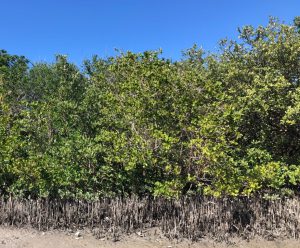
Mangroves are an important component of Florida’s coastal ecosystem. They provide habitat for many organisms and protect us from storms. Mangroves have been moving northward in Florida, and it is important all of us around the state to understand their ecology and how to interact with them.
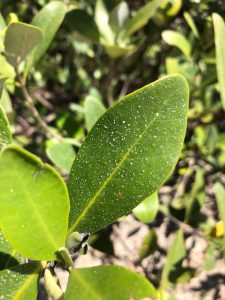
What are mangroves?
Mangroves are trees that live in the intertidal zone and are adapted to high salinity conditions. Most trees would die in salt water, but mangroves have adaptations to prevent some of the salt from entering the roots as well as concentrate and excrete salt that does enter. There are over 50 species of mangroves worldwide, but here in Florida we have three species, commonly referred to as red, back, and white mangroves.
How can I identify each of the three types of mangroves?
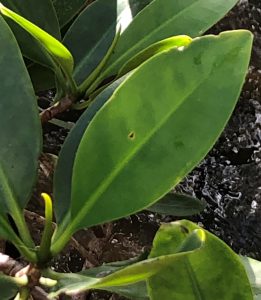
Red mangrove
Rhizophora mangle
Green on both sides of leaf, wavy top surface
Longer leaves with a point and the tip
Reddish prop roots extending down to the water
Propagules are long and cylindrical, green with some brown
Typically live right at the water’s edge
Prefer warmer conditions but is creeping northwards!
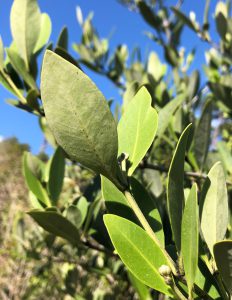
Black mangrove
Avicennia germinans
Leaves are green on the front, but a whiteish shade of green on the back
Long leaves with a pointy end (typically!)
Excrete salt and so the leaves sometimes have salt on the outside!
Have roots that stick up from the ground called pneumatophores
Propagules are small and a flattened bean-like shape
Live at the waters edge or slightly inland
Most tolerant of the three species to cooler weather
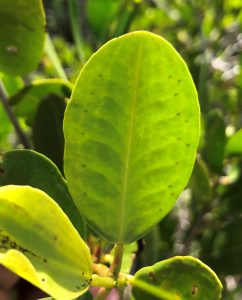
White mangrove
Laguncularia racemosa
Leaves are more rounded and circular
and there are a series of small pores that can be seen on the back
Has two bumps at the base of the leaves on the stem
(glands called extrafloral nectaries that secrete sugars)
Propagules are a small, flattened lens shape
Lives on higher ground (don’t like to get fully submerged in water)
Least cold-tolerant species
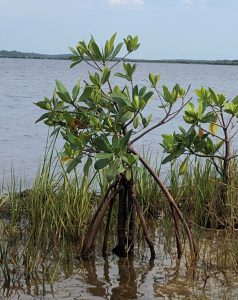
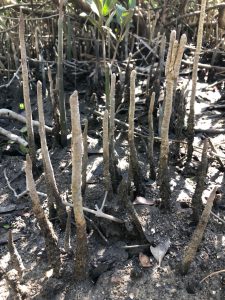
Why do mangroves have such unique roots?
Plants use their roots to take up nutrients and oxygen. The soils where mangroves live often has very low levels of oxygen, and so the tree cannot absorb sufficient oxygen through underground roots. Many mangroves have adapted to have aerial roots that are above the ground and have special holes for oxygen exchange. Red mangroves have prop roots that grown down from the trunk, whereas black mangroves have roots called pneumatophores that come up from the soil
Why are mangroves important?
Mangroves are important for so many reasons! Their positioning along coastlines and unique root structure account for some of their ecosystem functions. Mangroves:
- Create habitat for many organisms, from birds on the branches to invertebrates that grow on the roots to the fish that hide amongst the submerged red mangrove roots
- Serve as a nursery for many commercially and recreationally important fish species
- Stabilize shoreline and reduce erosion
- Absorb runoff, sediment, and nutrients and help promote good water quality
- Protect land from storms by absorbing wave energy
- Absorb and store carbon dioxide from the atmosphere
- Are plants that photosynthesize and produce oxygen
I have seen mangroves starting to grow in an area that used to be marsh. What is going on? Is this good? Is it bad?
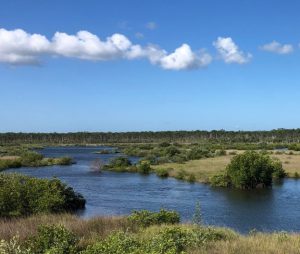
Florida is home to areas of both mangrove and salt marsh – what you have in your region depends on how far north or south you are in the state. Mangroves are well adapted to our coastal areas, but they don’t like the cold. Therefore, if you live down in south Florida, you will find mangroves along the coast, but up in the northern parts of the state (and states north of us) you will find salt marsh.
I work in Volusia and Flagler Counties, which is right at the point on the east coast of Florida where these two organisms and habitat types meet and mix. Southern Volusia’s estuaries were full of mangroves and then in the 1980s a series of hard freezes killed all the mangroves. Within a few years that area became a salt marsh. However, after many mild-weathered years, the mangroves reestablished and now our estuaries are once again full of mangroves.
A bit further to the north in Flagler and St. John’s counties you may have more salt marsh, but the mangroves are growing in abundance and range as we continue to have warmer conditions with fewer freezes. Mangroves can’t tolerate temperatures below about 25 degrees Fahrenheit for long (Cavanaugh, 2013). Therefore, if we have below-normal temperatures in the winter our mangroves may die back and salt marsh become dominant once again. However, if the currently observed warming patterns continue, we can expect to see mangroves expand northward in the state.
Both mangroves and salt marsh provide important ecosystem services. They both stabilize shoreline, prevent erosion, enhance water quality, and protect us from storms. They also both provide habitat to a variety of estuarine organisms. However, some differences do exist between the two habitat types, one of the main being that mangroves are a tree and create shade. Researchers are currently working to understand how a change from a salt marsh to mangrove habitat may affect the biogeochemistry of the area and the other organisms living in the area.
There are mangroves on my property. Can I trim them?
Mangroves are protected under Florida law and any projects that will alter or remove mangroves must go through a permitting process with the DEP. However, some mangroves can be trimmed. To trim a mangrove means to cut mangrove branches, twigs, limbs and foliage, but you cannot remove, defoliate, or destroy the mangroves, or to cut any of the roots. Whether you or a Professional Mangrove Trimmer trim your mangroves depends on several factors, including the height of the mangroves and whether the mangroves are found along the edge of the shoreline and less than 50 feet deep.
More details of guidelines on mangrove trimming and exceptions can be found in the Mangrove Trimming Guidelines for Homeowners handbook. Mangrove trimming regulations can be a bit confusing, and you want to make sure it is being done correctly so that you are following the law and minimizing your impact on the mangroves. If you have questions about regulations or trimming, reach out to your regional DEP mangrove contact. There is also a list of authorized Mangrove Trimmers, which you can review for a trimmer in your area.
What threats do mangroves face?
- Development: direct removal of mangroves or filling of wetlands
- Water pollution, including herbicides and oil spills
- Hurricanes (direct impact, flooding, smothering of roots with sediment)
- Freezes
- Conversion of wetlands into aquaculture land for shrimp (thankfully, this is not an issue in the US, but is in many places in southeast Asia and Central and South America. If you purchase farmed shrimp, make sure it is sustainably grown)
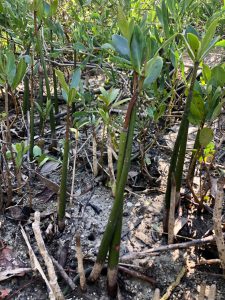
What can I do to help mangroves in Florida?
The most important thing we can do is to protect mangroves that are already established. Well established mangroves are more likely to survive storms and wave action, and they are home to a multitude of organisms. We can protect mangroves by following regulations prohibiting the removal and altering of mangroves, using Professional Mangrove Trimmers if trimming is needed, and supporting only responsible development that does not impact wetlands. In addition, we can make choices in our yards that will promote good water quality in our watersheds, such as choosing native vegetation and avoiding fertilizers. Finally, if there is an estuarine shoreline that no longer has native vegetation and is showing signs of erosion, a living shoreline that incorporates salt marsh and mangroves may help with both erosion control and habitat restoration.
 1
1
